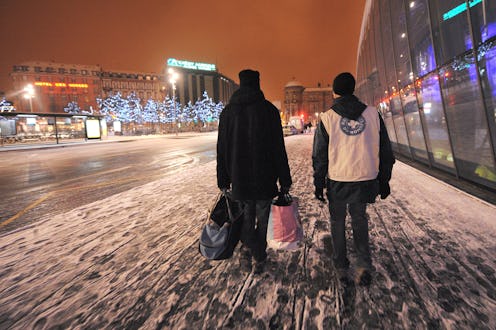News
Help Homeless People In Your Area Prepare For Juno
As Juno, more popularly known as the #blizzardof2015, approaches the Northeast and residents begin to stock up on supplies and plan for the snow day(s), thoughts also turn to the homeless population in the northeastern cities. Summer and winter are typically difficult times for the homeless population, and winter storms can make things more difficult. Bustle spoke with Michael Stoops, the director of community organizing at the National Coalition for the Homeless, to find out how people can help the homeless prepare for inclement weather.
The first thing Stoops recommends is to familiarize yourself with the shelters and resources in your neighborhood. "People should get on the Internet and learn that information so they can share it verbally with people on the streets," Stoops says. Then, “if someone sees a homeless person out in inclement weather, the best the person can do for that citizen is to ask that person does he or she know about the local shelter, do they need transportation, do they want to go there?”
Because, as Stoops pointed out, the average person isn’t always able to make medical assessments or provide the necessary assistance to a homeless person, it’s better to call a local hotline. Especially in cases in which a person doesn’t seem to have the mental capacity to make a decision for their safety. Dan Diamond, a Forbes contributor, complied a list of local hotline numbers for emergency services for the homeless.
Familiarizing yourself with resources for homeless people in your area also involves learning about your city's shelter system. According to Stoops, some cities around the country are required to provide shelter to the homeless in severe weather situations, whether it be in the form of providing extra sleeping room in shelters or renting motel rooms. The problem comes when the requirements for winter housing vary across the country. Hypothermia can begin to set in at temperatures as high as 50 degrees, especially when people already aren’t in good health, which can be the case for the homeless population, Stoops says. That’s troubling considering that cities such as New York City and Washington D.C. require 32 degrees, and Baltimore requires 13 degrees with wind chill for their winter shelters to open up. According to the Weather Channel, the temperature in Baltimore can get as low as 28 degrees during Juno and the Baltimore City health Department has issued a Code Blue for Tuesday and Wednesday.
Even if the conditions of Juno aren't enough for a Code Blue in your area, contacting local shelters are still your best option for helping the homeless. If you see a homeless person out in the storm, call 311 for information, and make sure they get to a shelter and out of Juno's way.
Image: National Coalition for the Homeless
Correction: A previous version of this article said that the Baltimore City Health Department had not implemented a Code Blue alert. This was incorrect. We regret this error.
